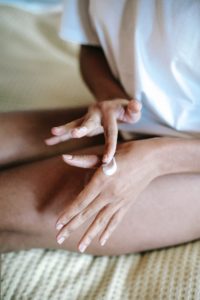For some time now, skincare products that contain alcohol have been under much scrutiny.
With much conflicting information online, it is no wonder the topic has become somewhat controversial in the beauty and skincare community. But what is the truth about alcohol in skincare? And what is the difference between regular body lotions and alcohol-free body lotions?
What Is The Definition of Alcohol In Beauty and Skincare?
When the word alcohol is used, most of us think of a beverage for adults such as beer, wine, or a spirit like Vodka. But alcohol in reference to a cosmetic or skincare ingredient is not quite the same. A skincare product that contains alcohol means that it includes molecular compounds that belong to a hydroxyl group.
A hydroxyl group implies that there is an OH bond present. In simple terms, somewhere there contains an oxygen atom bonded to a hydrogen atom in the lotion’s chemical composition. Alcohols are easy to recognise in the ingredient list as they tend to have names that end in the suffix “-ol”.
To prevent products from being used illegally, alcohols are often denatured to discourage people from consumption. These denatured alcohols will appear with the abbreviation “SD Alcohol” or “SDA” followed by a systematic combination of numbers and letters. This abbreviation is in line with FDA regulations. For European brands, the term “alcohol denat” is used instead.
Why Is Alcohol In Body Lotion?
Alcohol in skincare, such as body lotion, plays quite essential but different roles depending on what type of alcohol is used. Alcohol can be classified as low molecular weight or high molecular weight. The molecular weight of alcohol is determined by the average weight (or size) of a molecule that composes the alcohol. Low molecular weight alcohol has a different function to high molecular weight in body lotion.
Low Molecular Weight Alcohol In Body Lotions
Low molecular weight alcohols have the useful property of quick evaporation. Body lotion includes low molecular weight alcohols for the primary function of faster and more effective absorption of active ingredients. It also leaves a non-greasy feel and matte finish which might be preferable for some users.
The fast absorption property, however, is also a drawback for low molecular weight alcohol body lotions. This is because it can also allow the absorption of dirt, bacteria, and other undesirable particles. Furthermore, fast evaporation can pull moisture and strip away natural healthy oils from your skin. This will damage your skin’s protective barrier, leaving it dry and in worse condition.
Another major problem that low molecular weight alcohol can pose is irritation. Sufferers of skin conditions such as eczema and rosacea should be cautious. People with sensitive and dry skin may experience redness, stinging, and burning. Products containing fragrance and essential oils will heighten irritation further.
High Molecular Weight Alcohol In Body Lotions
High molecular weight alcohols – also known as fatty alcohols, are much more solid and waxy in texture. If a body lotion is heavier in texture, then it most likely contains high molecular weight alcohols. These alcohols serve multiple purposes in a lotion:
- to provide a thick, luxurious feel.
- to emulsify – keeps ingredients and water content from separating.
- to add emollience – smooths skin cells giving a softer and radiant finish.
- for humectant properties – locks in water for increased hydration.
A huge downside to high molecular weight alcohol in body lotion is that it is prone to clog pores. This can lead to blackheads, whiteheads, and acne. It can also cause irritation and allergic reactions as these alcohols are often derived from plants. Though it should be noted that these effects are much less likely than low-weight alcohols. Irritation caused by high molecular weight alcohols is more unpredictable and tends to occur on an individual basis.
What Are Alcohol-Free Body Lotions?
It is slightly misleading for body lotions to be labelled alcohol-free, as they will still contain alcohol. Alcohols are often included for their preservative and stabilising properties. But what matters is the kind of alcohol a body lotion contains. There are alcohols identified as “bad alcohols” and “good alcohols” with bad and good effects on skin.
What alcohol-free means in the beauty industry is the absence of “bad alcohols”. Here is a non-comprehensive list of good and bad alcohols:
Bad Alcohols For Skin
|
Good Alcohols For Skin
|
Conclusion
Alcohol in skincare has unfairly gotten a bad reputation because its different types with distinctive properties are widely misunderstood.
The difference between body lotions with and without alcohol is that body lotions without alcohol contain only good alcohol. Good alcohols are high molecular weight alcohols with nourishing benefits and are less likely to dry or cause irritation to your skin.
It is important to note that irritation is not solely dependent on the alcohol content of skincare products. Factors such as formulation, personal tolerance for ingredients, and relative concentrations of ingredients should also be considered. The specific combination of products in a skincare routine can also affect the level of irritation.
When shopping for body lotions, pay attention to the ingredients and identify what your needs are for your skin type to determine better which body lotion you should be purchasing.





